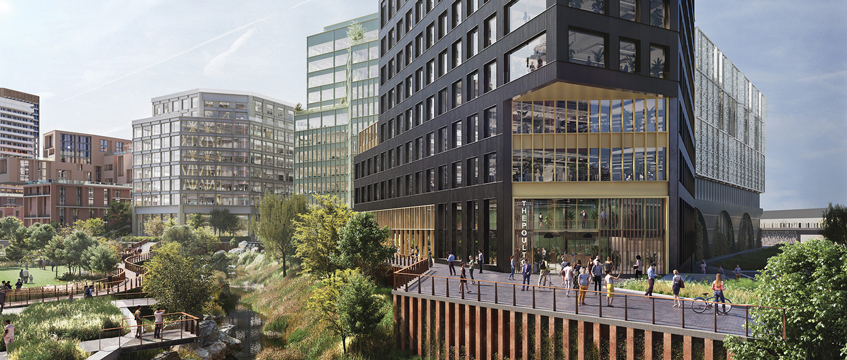While many developers like to say their latest project has transformed the local area, U+I has a better claim than most at Mayfield Park. Spanning 6.5 acres, the park – which opened last week – is the first in Manchester’s city centre for more than a century.
For Mike Hood, chief executive of U+I – which has formed the Mayfield Partnership joint venture alongside LCR, Manchester City Council and Transport for Greater Manchester – the scheme gives the city centre something it has long been missing: “good-quality, public, open green space”.
“Manchester has a heritage of being very dense in terms of its usage. It was very difficult to squeeze green space into this place,” Hood said on a tour of the park with EG the day it opened. “For us, it was the absolute fundamental principle to create a scheme that is based around green space, biodiversity and wellness.”
Hood was promoted from managing director to chief executive of the regeneration specialist when the firm was bought by Landsec in a £190m deal in December 2021. Alongside the day-to-day leadership of the business, Hood took over the lead on the Mayfield scheme in Manchester from Richard Upton, who became a part-time senior adviser to U&I.
Mayfield Park sits at the heart of a wider £1.5bn regeneration scheme, featuring 1,500 new homes, 1.6m sq ft of commercial space, 300,000 sq ft of retail and leisure facilities and 14 acres of new public realm.
“One of the key challenges of this park was uncovering the [River] Medlock, which was hiding underneath the buildings and the concrete slabs,” said Hood.
The site had previously served as an ancillary railway station for Manchester Piccadilly, a railway depot, a brewery and dye works. The transformation of the site started pre-Covid, with the pandemic hurting the project “pretty much as everybody else”, Hood said. There were also challenges to the project from Brexit, such as buying materials from Europe.

“With the support of the city council and the combined authority, we were successful in getting a grant from the government’s Covid Recovery Fund, which allowed us to get on with this park,” says Hood. “From that point forward, we set ourselves an extremely aggressive programme to open the park.”
As Hood took to the stage to cut the ribbon at last week’s opening ceremony, the rain started to pour down. “It’s Manchester,” he said with a laugh. “Why would you expect a different kind of weather here?”
But minutes later, the sun broke through the clouds, and the beams recovered from what used to be the railway depot started to shine.
“As you walk around, you’ll see a whole series of beams here,” Hood said. “There is also one of the footings for the old steam engines that used to power the factory. Underneath, they had a whole series of channels that used to carry the dyes around.”
There were other discoveries awaiting the team. “We found a whole series of wells on the site which were originally there to support the industrial use,” said Hood. “What we were able to do is uncover those wells, check that they were clean and met the modern standards, and now we use all those wells for irrigation around the site.
“We were working really carefully with our team of engineers and architects to look at these objects and how we might bring them into new use.”
When asked what regeneration means to him, Hood described the concept as a careful process of looking both backwards and forwards, and coming up with the right mix of uses to create a vibrant location. He expects U+I to benefit from the new ownership of Landsec as it pushes ahead with its goal of being a long-term curator of places.
“I don’t think regeneration stops at a point where you finish a project,” Hood added. “The curation of a place in the long term is what generates the most value – not just in financial terms, but value in the broadest sense for the local communities in the cities in which we create these projects.”
As the first phase of the wider masterplan is now complete, U+I is readying itself to move forward. The next developments on the list are two office buildings of 80,000 sq ft and 240,000 sq ft, and a car park.
“We will arrange a whole series of new and refurbished spaces around the park,” said Hood. “So when it’s finished in eight years or so, it will have homes for around 4,000 people and workspace which will, we hope, generate 13,000 to 14,000 jobs.”
To send feedback, e-mail evelina.grecenko@eg.co.uk or tweet @gre_eve











